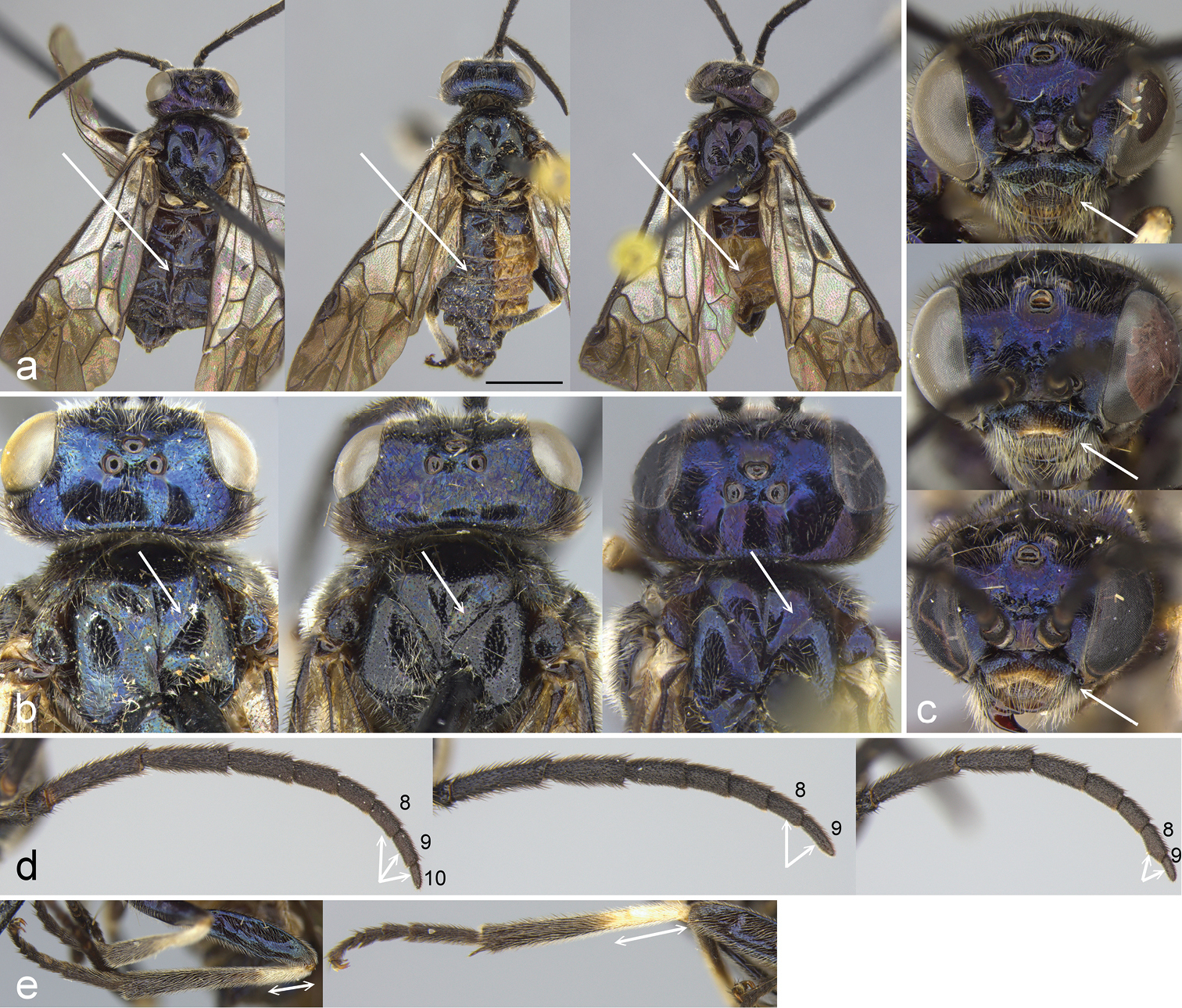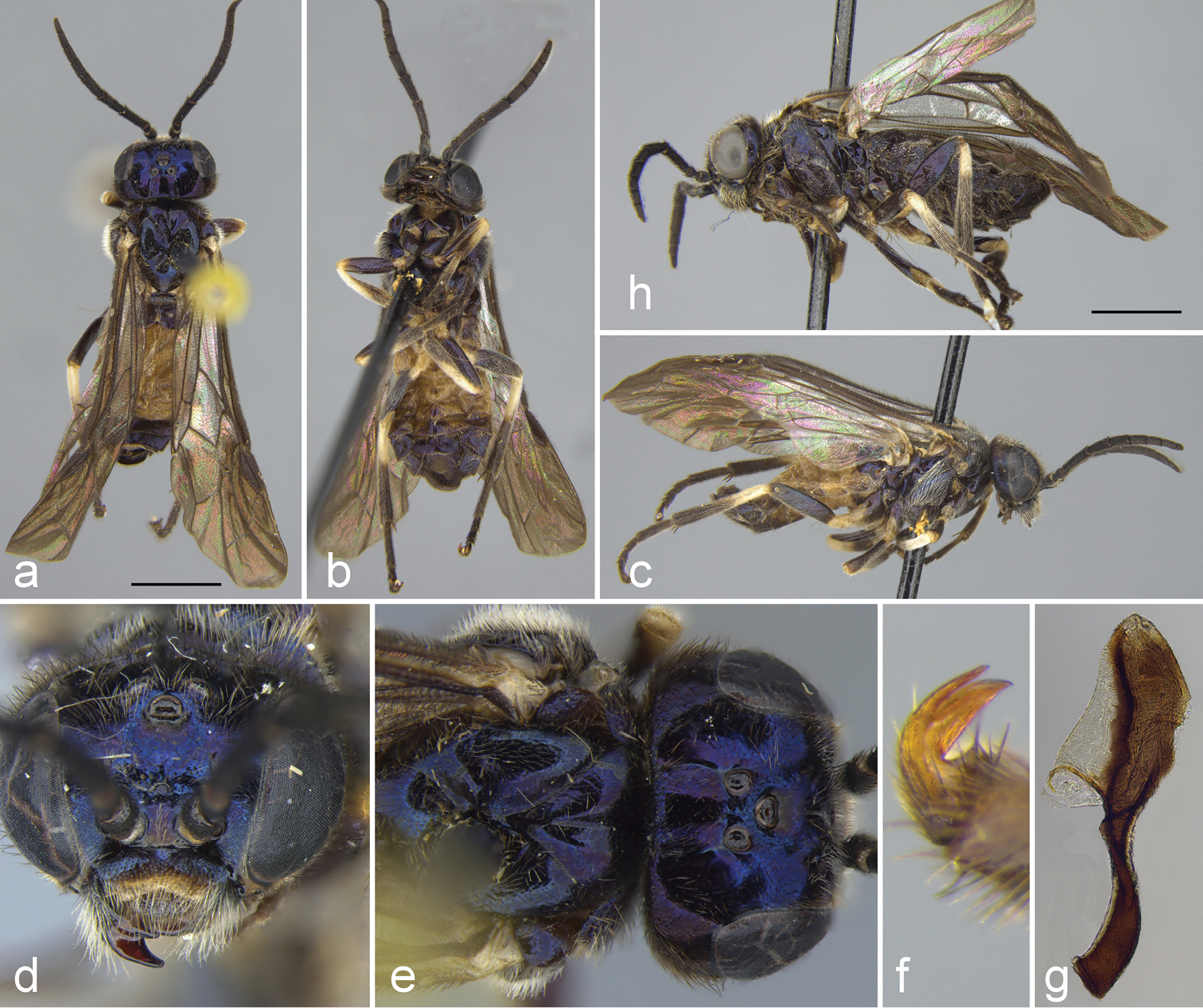






(C) 2013 Andreas Taeger. This is an open access article distributed under the terms of the Creative Commons Attribution License 3.0 (CC-BY), which permits unrestricted use, distribution, and reproduction in any medium, provided the original author and source are credited.
For reference, use of the paginated PDF or printed version of this article is recommended.
Citation: Taeger A (2013) Intraspecific variability of the Lygodium sawfly, Neostromboceros albicomus (Konow, 1900) (Hymenoptera, Tenthredinidae, Selandriinae). Journal of Hymenoptera Research 35: 91–96. doi: 10.3897/JHR.35.6341
The intraspecific variation of Neostromboceros albicomus (Konow, 1900) in a restricted area in Thailand is described. The value of characters, some of which are used for separating species and species groups in Neostromboceros, is discussed. The male of N. albicomus is described here for the first time.
Intraspecific variability, Selandriinae, Thailand
Neostromboceros Rohwer, 1912, originally described as a subgenus of Stromboceros Konow, 1885, comprises today 154 nominal taxa of which about 135 are currently considered to be valid (
The identification of Neostromboceros species is difficult, and usually great uncertainties remain. The most comprehensive keys to species were published by
For this study, 39 specimens of Neostromboceros albicomus were examined from Thailand, Chiang Mai Province, collected by Saowapa Sonthichai with Malaise traps, with the following label data:
1–10 August 1997: 18.692°N, 98.816°E, 270 m. Pa Huay Thong: Thambon Nam Bo Luang. Amphur Sampatong (7 ♀).
10–20 August 1997: 18.542°N, 98.954°E, 250 m. Pa Huay Thong: Thambon Nam Bo Luang. Amphur Sampatong, in field at edge of mixed deciduous forest (2 ♀).
1–10 September 1997: Rim Pa Huay Tong, 18°48.07'N, 98°57.27'E [= 18.801°N, 98.955°E], 270 m. Thambon Bo Luang [sic!]. Amphur Sampatong, at edge of deciduous forest (11 ♀, 2♂).
10–20 September 1997: Rim Pa Huay Tong, 18°48.07'N, 98°57.27'E [= 18.801°N, 98.955°E], 270 m. Thambon Bo Luang [sic!]. Amphur Sampatong, at edge of deciduous forest (12 ♀, 2 ♂).
20–30 September 1997: Rim Pa Huay Tong, 18.801°N, 98.938°E, 250 m. Thambon Nam Bo Luang. Amphur Sampatong, in mixed deciduous forest (3 ♀).
Photos were taken with a Leica DFC 495 digital camera attached to a M205 C stereo microscope. The penis valve was photographed with a Leica DFC 450 digital camera mounted on an Olympus BX.51 microscope. Extended depth of field images were created with CombineZ5.3 and finally arranged and partly enhanced with Ulead PhotoImpact X3. The pictures reproduced in this paper, as well as views on other specimens, are accessible at full resolution under https://doi.org/10.6084/m9.figshare.798854. The specimens examined are housed in the entomological collection of Utah State University, Logan, USA, and in the Senckenberg Deutsches Entomologisches Institut, Müncheberg, Germany.
Of the 39 examined specimens, 19 with partly yellow-red abdomen run in the keys (
Both color forms were found at all four localities; the clypeus is in most cases completely blue-black, but at all localities specimens with a pale marked clypeus also occur (Fig. 1c),
the depth of the apical emargination of the clypeus varies about between 15 and 30 % of its length (Fig. 1c),
the pale marked clypeus may be found in both color forms (Table 1),
specimens with a pale marked clypeus usually also have more extensively pale marked legs,
the specimens with the palest legs have hind tibiae with more than the basal third pale, whereas in the darker forms only about the basal quarter is pale (Fig. 1e),
the trochanters become paler from the front to the hind legs,
the hind trochanters are usually more or less darkened on the inner side, but in pale specimens may also be completely pale; the tegulae are usually completely blue-black, in several specimens the basal area is more or less pale,
the blue or more or less purple metallic luster is sometimes reduced on larger parts of the body and simply appears black (Fig. 1b),
the size and density of the pits on the thorax and head are variable, but in a large majority of specimens the pits are scattered and small (Fig. 1b),
the apical antennomeres are variable in size,
the number of antennomeres is 9 or 10 (Fig. 1d) and frequently differs between antennae of a single specimen,
intraspecific variation seems to be independent of the sex.
Neostromboceros albicomus, various specimens, both sexes. a color of abdomen (females, scale 2 mm) b color and density of pits on mesonotum c color and shape of clypeus d shape of apical antennomeres e color of hind tibia.
Color patterns of clypeus and abdomen in Neostromboceros albicomus, sorted by collecting event and sex. Intermediate female from 1–10 September not included.
| collecting event (date and site) | specimens, sex | abdomen and clypeus blue-black | abdomen blue-black and clypeus pale marked | abdomen mainly pale and clypeus blue-black | abdomen mainly pale and clypeus pale marked |
|---|---|---|---|---|---|
| 1–10 August | 7 ♀ | 2 | 1 | 3 | 1 |
| 10–20 August | 2 ♀ | 1 | 1 | ||
| 1–10 September | 10 ♀ | 1 | 3 | 5 | 1 |
| 1–10 September | 2 ♂ | 2 | |||
| 10–20 September | 12 ♀ | 5 | 1 | 6 | |
| 10–20 September | 2 ♂ | 1 | 1 | ||
| 20–30 September | 3 ♀ | 1 | 1 | 1 |
The male of Neostromboceros albicomus was undescribed (
Neostromboceros albicomus, males. a–f pale specimen a dorsal (scale 2 mm) b ventral c lateral d face e head and thorax, dorsal f claw of hind leg g–h dark specimen g penis valve h ventrolateral view (scale 2 mm).
The available material revealed an unexpected high level of intraspecific variation in Neostromboceros albicomus. This is an example of a phenomenon that may be more widespread within the taxonomically very difficult genus Neostromboceros. Unfortunately, the characters that were shown to be highly variable are frequently used for the separation of species or species groups in Neostromboceros. The present study demonstrates that the description of new taxa from only few specimens or singletons, a common practice in the past, should be avoided because of the high risk of describing variants of known species. The inclusion of genetic information could help to solve problems related to color variation in the future.
Many thanks to Frank Koch (Berlin), Brian V. Brown and Meiping Xie (Los Angeles, CA) and James Pitts (Logan, UT) who made the material available to me for examination. Thanks also to Dave R. Smith (Washington, DC), Stefan Schmidt (Munich), Stephan Blank, Andrew Liston and Marko Prous (Müncheberg) for helpful discussions. A. Liston kindly corrected the English of the paper.

